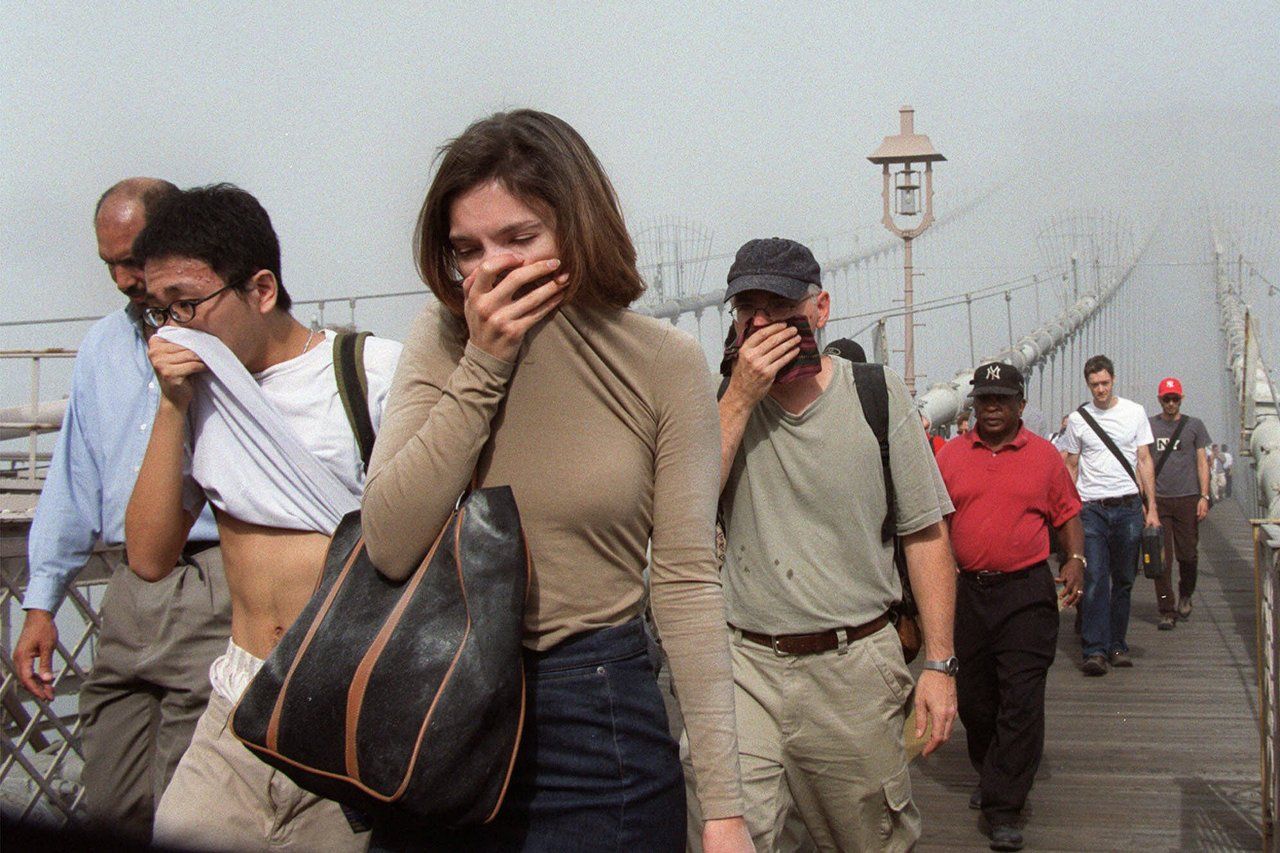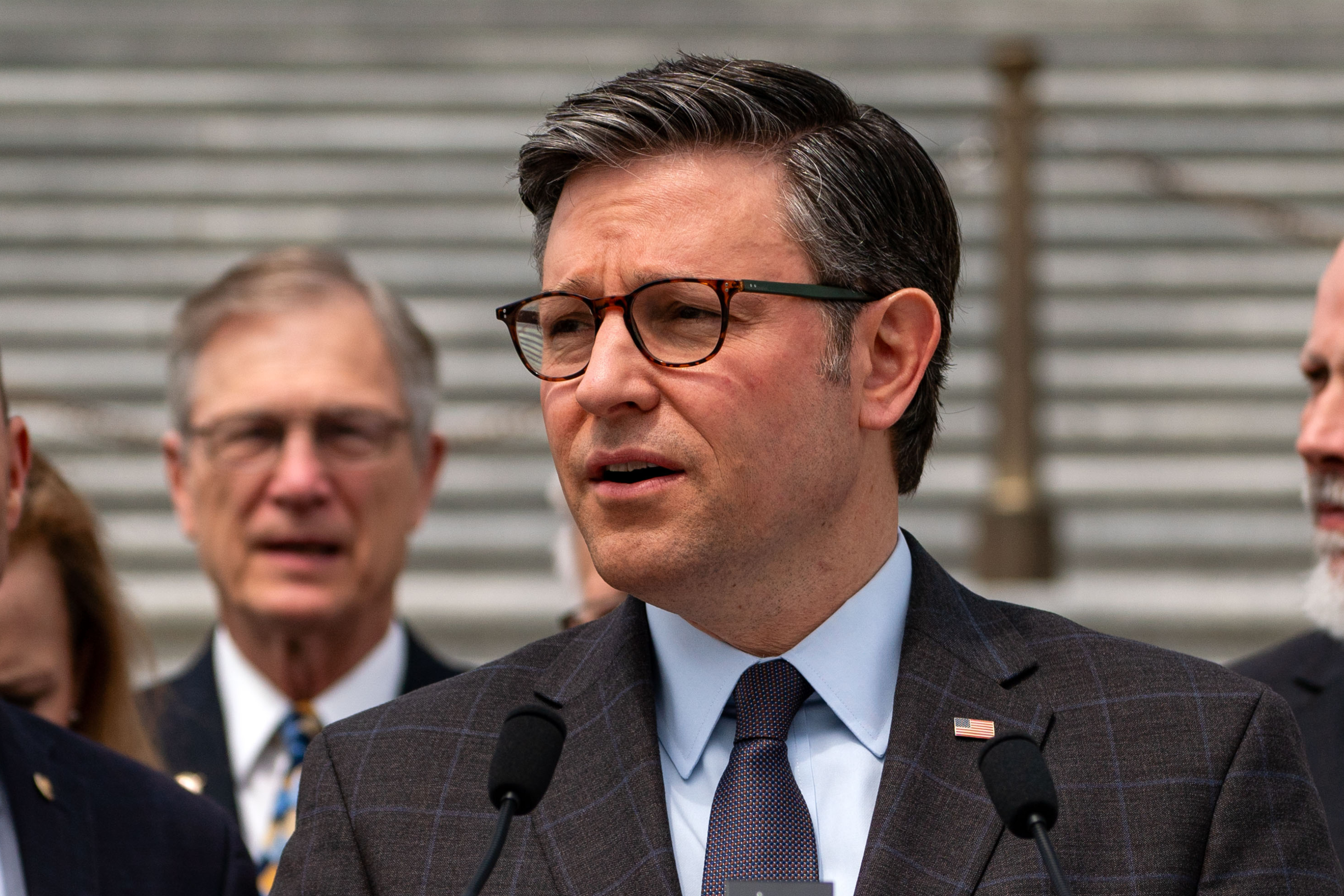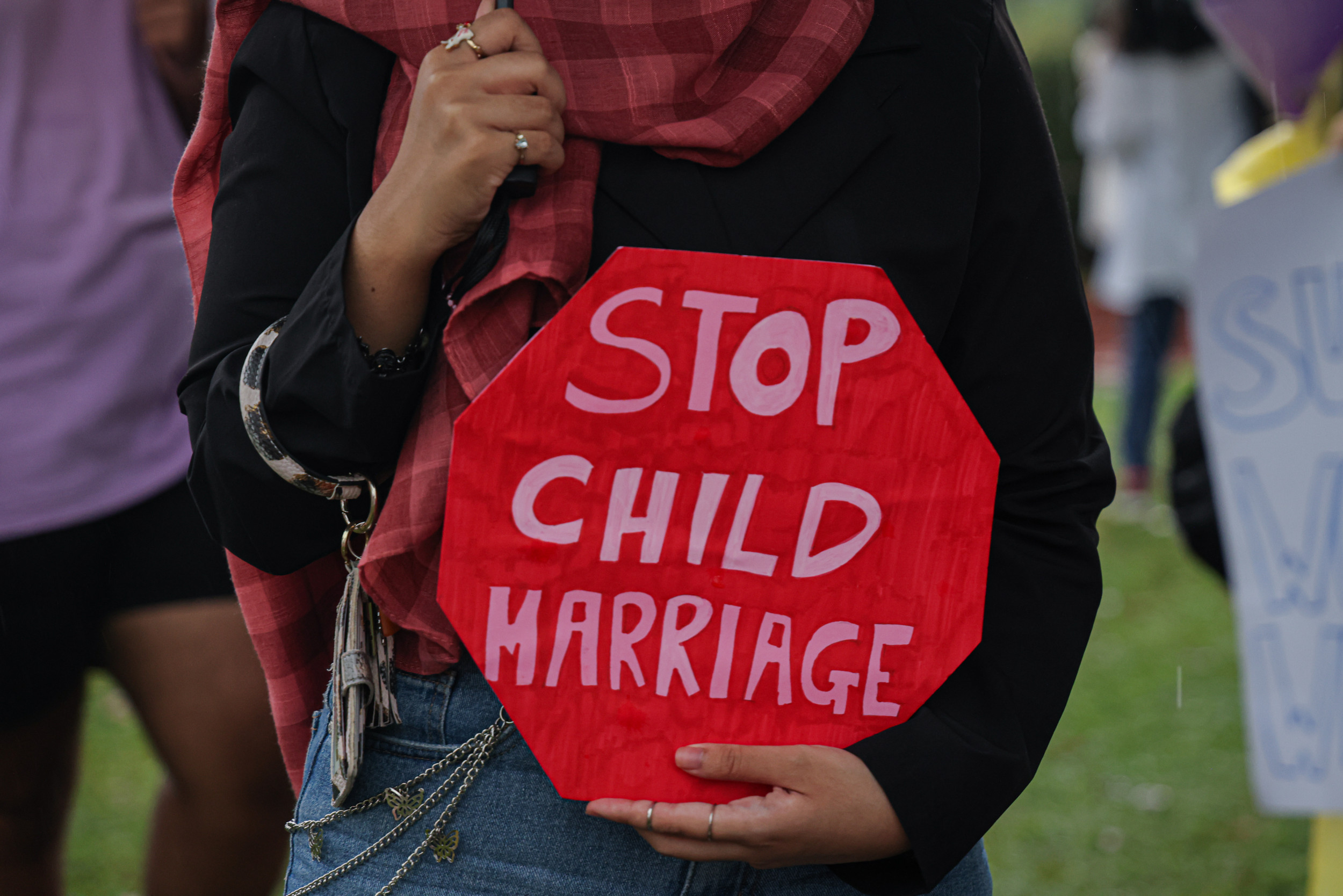
The first blast shook the building where Bill Kimak lives, a few blocks from the World Trade Center. "I ran to my window and saw people running, but I didn't understand what was going on. Then I looked up. All I could see was all the fire and smoke and bits of building and paper floating around like confetti. As I watched, I saw 15 or 20 people literally jump out of their windows and fall to their deaths. Then there was the second explosion--so powerful it knocked me back. They evacuated all of us and told us to walk north. We had to wet paper towels and hold them over our faces so we could breathe. It wasn't until I got to my office, in midtown, that I realized my hands were shaking. They're shaking now. And there's nothing I can do about it."
At St. Patrick's Cathedral, every one of the hundreds of prayer lights had been lit by 2 in the afternoon. Lynda LaSalandra and Tina Hight, visiting Manhattan from Mill Valley, Calif., were here praying for the destruction to stop. It was their second church of the day. "You just don't believe it's real," said LaSalandra. "It's like a Jerry Bruckheimer movie."
Brian hughes, a volunteer at NYU Hospital, first heard the news on the radio. "I knew it had to be major to break into Howard Stern."
In a restaurant in Moscow, men crowded around a television--Russian TV carried CNN. "Our government has always said that we need to fight terrorism together," said 70-year-old Viktor Tikhonov. "Maybe they were right for once."
Downwind from the World Trade Center, across the East River in Brooklyn, white particles the size of wet snowflakes fell throughout the morning; as night came on, the smell of acrid smoke grew stronger, and JFC Paints on Court Street had sold carton after carton of painter's masks. In some neighborhoods, papers from offices in the WTC littered the treetops. On Dean Street, two neighbors sat on a stoop, trying to comfort a third whose boyfriend still hadn't called. A passerby reached down and picked up three manila file folders, charred around the edges. "Anybody want a souvenir?" Nobody did.
Traffic had stopped, but pedestrians crowded across the Manhattan Bridge over the East River into Brooklyn--about a quarter of them wearing dust masks distributed by emergency workers, and most of them dusted with gray powder. And since cell phones were down, every single pay phone for a half mile along Flatbush Avenue had a dozen people standing in line to call home.
In Brooklyn Heights, one man was walking the opposite way, toward the Brooklyn Bridge heading into Manhattan. He had his two daughters with him, and both their backpacks slung around his neck. "I live over there," he said, pointing across the river. "Two blocks from the World Trade Center. The minute I heard the crash I jumped on the subway before they shut it down to get over here and get my girls. They go to school in Brooklyn. I know 40 people who work on the 106th floor. They're just not there anymore. I saw five people jump from the building. It was horrible." When he was told he'd performed a heroic action, he said, "I'm not doing squat. I'm just trying to get to my family. Say a prayer." As he walked on, one of his daughters said, "But Mommy works in the World Trade Center." He gripped her hand tighter and said, "Well, we hope Mommy's all right."
Amtrak train 172 left Philadelphia for New York about 9 a.m.; by 9:30, cell phones were ringing. "What? Two planes? What? Oh, my God." An elderly couple with tickets to "The Producers" were particularly upset. "We'll never get to see the show!" the woman wailed. "We had such a nice trip planned." As Manhattan's skyline came into view, one woman kept staring. "I thought there were two towers," she said. "I thought there were two." At 10:20, the train pulled into Penn Station; the cell phones had stopped working. One young man, a 16-year-old tourist from Taiwan, sat weeping on the exit stairs as fellow passengers poured around him. "I don't know what to do," he said. "I have nowhere to go. No one to go to."
All around the World Trade Center, the air reeked of burning rubber. Paper, debris and soot inches thick covered the pavement, burned-out cars and buses lined the streets, and the West Side Highway was clogged with people walking north and emergency vehicles going nowhere. Near the corner of the highway and Chambers Street, a fireman leaned over and drank straight from a gushing hydrant. You could hear occasional explosions: cars blowing up, one by one, in a nearby parking lot. Several firefighters leaned against the hulk of a trashed Ford Taurus. "There's people still alive in there," one said. "There's got to be. This is helplessness."
A WTC fire-safety official named Kevin Horan had been trapped under a fire truck and broken his arm. "There were body parts for blocks," he said. "And jumpers. Tons of them." Firefighter Claude Kebbe, whose company came in from Queens, saw the jumpers too. "Unreal. Every time you looked up somebody else was jumping. I guess when you're burning alive you do stupid things. Nobody's had experience with something like this before."
Many of the most serious injuries were rushed to Bellevue Hospital, where the line of blood donors snaked around the courtyard. "We've only been in class for three weeks," said first-year med student Matt Teicher. "There's not much we can do other than give blood ourselves." A city corrections officer named Steve Phillips was manning the line. A while ago, he said, he'd spoken to a fireman who hadn't been able to get far into the Trade Center. "He and his buddy stepped in," Phillips said, "and a body came falling out of the ceiling."
In Greenwich Village, a crowd formed around a stolid policeman. News issued from a tall walkie-talkie on his belt, and as he stared into the middle distance, they leaned down to listen.
Tens of thousands of people headed uptown, many pressing dead cell phones to their ears. A man in a dust-covered Yankees cap pulled up on a bicycle. "I seen both of 'em fall," he said, to nobody and everybody. "I seen people crying. I seen people jumping out." At 34th Street, a man and wife in standard-issue tourist pastel shorts were turned away from the Empire State Building. But, almost defiantly, the man pulled out a camera and aimed it upward, to photograph the monument that was still standing.
Several hours after the attack, an EMT in blue scrubs stood waiting outside Beth Israel Hospital on East 15th Street--but for what? "The sad thing is," he said, "that at this point I think it's all going to be dead on arrival. We're well past the golden hour."
When a University of Chicago child psychologist checked his e-mail Tuesday morning, he found this message from a friend. "I was 11, playing chess with my father on Dec. 7, 1941, on a quiet Sunday in Baltimore when the Pearl Harbor news came over the radio... feels exactly the same. Life is going to change, and fast."
On the subway, a young woman in pearls, heels and short dark skirt wept as other riders tried to comfort her. She was a secretary at Lehman Brothers in the WTC, and was alive only because she'd arrived a bit late for work this morning. "I saw it all, I saw it all," she cried. She'd just stepped out of the subway when the sky above her exploded. Then it began raining glass and bits of concrete. "I ran," she said, sobbing. "I saw people lying on the street screaming. One man had his face slashed open. There were little children. I didn't stop to help them. My only thought was to save myself. They were hurt. They were dying. I couldn't help them."
She calmed down, sobbed again. "Three of my friends are dead." An older woman told her, "You couldn't do anything. You had to save your life." The words seemed to have little effect. "All of you," the young woman said to the passengers at large, "you should all thank God you're alive. For what you have. That you didn't see the s--- I saw this morning."
Liberty Street was no longer a street, but a pile of debris. Firefighters gingerly climbed heaps of metal, leaning over and staring into a jumble of twisted beams. "There's part of a body over there," one fireman said to another, and pointed into the wreckage. "Was he in uniform?" the other asked. Jason Braunstein made it down to the street from his 87th-floor office. "In the courtyard I saw things that no one should ever see. Things I can't talk about. Body parts. Pieces."
Outside St. Vincent's Hospital, city corrections officer John Flanagan leaned against a police barricade, smoking a Marlboro, as doctors inside cared for his brother-in-law, a New York fireman. He and a friend had jumped on their motorcycles when they heard hundred of firefighters and police officers were trapped in the World Trade Center. As they reached ground zero, Flanagan said, "people were actually jumping right in front of us, just splattering."
Aron Kirsch, a 28-year-old city planner, worked about 12 blocks from the WTC. He heard an explosion, rushed out into the street and saw people jumping out of a seven- to nine-story hole in the North Tower. "It was more than horrible to watch." Following police orders, he set off across the Brooklyn Bridge; halfway across the span, someone yelled at him to turn around: the South Tower was imploding. "At that point," he said, "there was mass hysteria. People started screaming and running everywhere. I held to the rail. I didn't feel like being trampled to death."
At Harvard-Westlake school, a prestigious prep school in L.A., arriving students were hustled into a special assembly, then sent off to classes. Headmaster Thomas C. Hudnut decreed that all history classes devote the day to the news. "These teachers," Hudnut said, "seized the teachable moment." Nini Halkett asked her 11th-grade AP American-history class why terrorists hate us so much. "Because we get involved in foreign affairs when it's not our place," said Cami, 16, "and because we have an elitist attitude."
Joshua Fifer, 21, a student who lives four blocks from the World Trade Center, was evacuated too quickly even to grab shoes, and made his way north on Broadway barefoot. "I saw at least seven people jumping out of the building," Fifer said. "You can see a person going straight down, no floating or anything. It's the sickest thing you've ever seen in your whole life."
On Canal Street, Greg Ciaverelli was still reeling from what he'd witnessed from his window at Goldman Sachs. "A woman I work with says, 'What's with all the paper outside the window?' I thought someone was throwing something from their building. So I go to the cafeteria to get a Diet Coke, and you could see the fire in one building, and as we stood there I saw a second plane crashing into it. I consider myself pretty educated, and I couldn't describe what we saw." He stopped for breath. "Right now, I don't know where my roommate is," he went on. "He worked in the World Trade Center. On the 85th floor."
At an auto-body repair shop in Willowick, Ohio, 20 miles east of Cleveland, owner Andy Yano, 47, was listening to the radio with his two mechanics. Yano considered himself conservative, but not a gun-loving nut case--until today. "Right now," he said, "I want whoever did this blown off the planet."
The dust hadn't settled from the World Trade Center's collapse when Osama Siblani's phone rang. "You'd better pray to God that Arabs didn't have anything to do with this," an unidentified voice told the editor of The Arab American News in Dearborn, Mich., "or your a-- will be next."
Dr. Paul Appelbaum, president-elect of the American Psychiatric Association, said his daughter had recently come back from a month in Israel. "At the airport she saw a backpack and immediately wondered why someone wasn't with it. What if it was a bomb? Then she stopped herself and said, 'No this is the United States. I'm not in Israel. I don't have to think like that anymore'."
Shannon Greenfield, 26, teaches first grade at PS 234, two blocks from the World Trade Center. When the school was evacuated, she ended up taking care of a 6-year-old girl named Alexis. "She was running alongside me and I was holding her hand. Her shoe fell off, but she was such a trouper. Then I saw this emergency bus going by. I screamed out, 'I'm a teacher, this is my student, we have to get on!' And while the bus was still moving they dragged us on. Everyone on the bus had been in one of the buildings, so they were covered with mud and soot and ash.
"When we got to PS 41, we had to wait for her father. He worked in the WTC--a lot of our kids' parents do. I can't believe it, but somehow he found us there. He came in with an oxygen mask on, but he was so calm. He hugged his daughter and said, 'Hi, sweetie. I'm here to pick you up.' She said, 'What's that mask for?' And he said, 'Oh, it's just something I decided to wear to work today'."
Sascha Mundstein, 33, a CEO who'd arrived from Vienna two days before, was about two blocks away. "I saw a man with a hole in his head," he said, "so I took off my shirt and wrapped it around his head, and just then an ambulance came. But they didn't want to take him because there were so many other injured."
Mike Frankel, 19, a student at the Borough of Manhattan Community College, stood at 199 Church Street, just behind the police lines, talking to his mother on his cell phone. "Ma, I saw 50 people die. I saw the buildings drop right in front of me. I came out of school and saw people jumping out of the buildings. I saw everything."
Some 200 construction workers gathered near the site to help out, writing their names and addresses in case they, too, were lost in the wreckage. "I was working at 110 Church," said one, "and I saw the turbine engine of the jet fly by our building and land in front of the Burger King."
Clayton Hill, 23, was on the number 2 train, on his way to work. The train was stuck for about 10 minutes, then started again and let everyone out at Chambers Street and West Broadway. "When I got out of the sub- way station and looked up it was mayhem," Hill said. "Every 10 seconds a body would fall from the tower. Each time the crowd would gasp. Everyone was clueless." Hill saw plenty of rescue trucks racing toward the building, but none coming back.
Trauma surgeons who had been attending a Montefiore Medical Center seminar near Madison Square Garden were bused to the area to help. But Dr. Andrew Renner, who practices in Burbank, Calif., realized it was pointless. "This is a nightmare," he said. "We haven't seen any wounded. You're either going to walk out of there or you're dead."
At the triage center on North Moore Street, police picked up bullhorns to plead with the crowds. "You could breathe asbestos in here and die, that's all you're doing. Go home! Being here as a sightseer doesn't help." But some in the crowd were desperate for news of loved ones; others tooled around on Rollerblades. "Write this down," said a redheaded man with a thick accent. "This is a wake-up call for the rich. Be sure to write that down."
An EMT named Bill Lipscomb, 36, got into an ambulance with a renegade driver. They rushed toward the towers after the first had collapsed but before the second went down, and picked up two injured people. "We were really close," Lipscomb said. "The soot was a foot deep. This guy was an a--hole, though. We picked up the two patients and then he drove around sightseeing instead of taking them to the hospital."
Karen Seong, 29, was on her way to work at the architectural firm of Skidmore Owings & Merrill. She never made it. When the first tower collapsed, she said, "You couldn't move. It was like being in a dark room." The streets were littered with paper, insulation, shards of metal. The air smelled toxic. "I could feel the debris up to my knees." Seong heard people throwing up, yelling, "I'm going to die!" Others yelled, "We're not going to die!" And she distinctly heard someone in all this chaos crying, "Don't leave anybody behind!"
Uncommon Knowledge
Newsweek is committed to challenging conventional wisdom and finding connections in the search for common ground.
Newsweek is committed to challenging conventional wisdom and finding connections in the search for common ground.
About the writer
To read how Newsweek uses AI as a newsroom tool, Click here.






